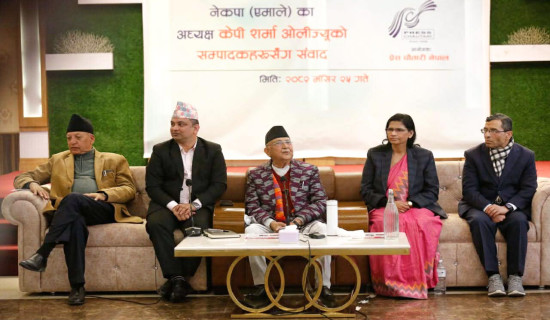- Thursday, 11 December 2025
Loss of lives in elephant rampage continues
Kathmandu, Mar. 11: Dev Prasad Sada, 22, of Golbazar Municipality-3 Jamdah Purandihi of Siraha died after being attacked by a wild elephant on last Tuesday.
Sada was attacked by the tusker when he had gone for a walk with his friends in the forest near Saday village after celebrating the Holi, festival of colour. Being injured in the attack, he was taken to the Health Care Centre in Golbazar but died before starting the treatment.
Similarly, Gapan Darlami, 45, a resident of Tangiyabasti, Jitpur Simara Sub-metropolitan City-16 in Bara district, died when a wild elephant attacked him on his way back home from a forest after collecting firewood on March 1.
Sada was the latest victim of a wild elephant attack in the country. With this, the number of elephant-induced casualties reached 317 in the last 23 years.
Attacks on humans by Asian elephants is a serious issue in the southern lowland of Nepal where elephant-related human fatalities are higher than other wildlife.
Asian elephant (Elephas maximus), a globally endangered mega-herbivore, is an umbrella species in tropical and subtropical forests of Asia and has a strong cultural role in various Asian societies but the human-elephant conflict has become a major concern in the local community.
Detailed understanding of elephant attacks on humans in Nepal is still lacking, hindering the planning of appropriate strategies for human-elephant conflict mitigation, said Dr. Ashok Ram, chief conservation officer at Parsa National Park.
Dr. Ram, who is also an elephant researcher said now wild elephants have started encroaching on human settlements. They have been harassing the people living in the buffer zones. They are killing people as well as damaging crops. Elephants cause the highest number of human deaths among the wildlife species in Nepal, he added.
Historically, 100 elephants used to migrate annually from West Bengal (India) entering Nepal from the eastern border during September–October and May–June. While migrating, they often came into confrontation with people as they are forced to travel through settlements and agricultural land, with a large part of their historic migration route encroached by people, said a research “Patterns and determinants of elephant attacks on humans in Nepal” conducted by Dr. Ram.
A fence installed in Bahundangi area in the Jhapa district at the eastern border of Nepal has contributed to reducing human–elephant conflict in the fenced areas. However, the elephants continue their movement to Nepal from south of the fenced area. Some elephants, especially males, break the fence and continue their movement up to Koshi Tappu Wildlife Reserve (KTWR) and westwards. A quarter of all elephant attacks on humans in Nepal occur in KTWR and its periphery.
There were 412 records (274 fatalities and 138 injuries) of elephant attacks on humans for the period of 2000–2020 June, Dr. Ram said. The attacks inside forests peaked during the afternoon when human activity, mainly cattle grazing, and fodder and forest resource collection would remain high inside the forests, according to the research.
“We compiled all the documented incidences of elephant attacks on humans in Nepal for the last 20 years across the Terai and Chure regions. The majority of the victims were males (87.86%) and had a low level of education. Males are the most victim as they chase elephants most of the time. One-fourth of the attacks occurred while chasing the elephants.”
Elephants are found in four population clusters -- eastern (Koshi to Jhapa), central (Chitwan to Mahottari), western (Bardiya to Dang), and far-western (Kanchanpur and Kailali). Elephants frequently migrate along Nepal–India border through forest passage in the Indian region along the east (northern part of West Bengal), west (Uttarakhand), and a few localities in the south (Bihar and Uttar Pradesh), Dr. Ram said.
People who were drunk and chasing elephants using firecrackers were more vulnerable to fatalities. Elephant attacks were concentrated in the proximity of forests primarily affecting the socioeconomically marginalized communities, the research revealed.
According to Dr. Ram, rapid development of linear infrastructures including railways, highways, electric transmission lines and irrigation canals cause further obstruction to elephant movement.
Elephants require large areas for their survival with long-distance seasonal movements. However, increasing habitat fragmentation brings them in frequent confrontations with humans.
According to the Department of National Parks and Wildlife Conservation, the government a cash compensation of Rs. 1 million to the family of a person killed in a wildlife attack, as per the existing Wildlife Damage Relief Guideline.
Similarly, a person who suffers serious injuries in a wildlife attack gets compensation of Rs 200,000, whereas a victim with minor injuries receives Rs. 20,000. The government also provides cash compensation for crops damaged by wildlife.
The victim or the family concerned should submit an application to the authorities concerned for claim compensation within 35 days of the incident.
There are 397 elephants in Nepal. Among them, 227 are wild and 70 are domestic elephants.
















